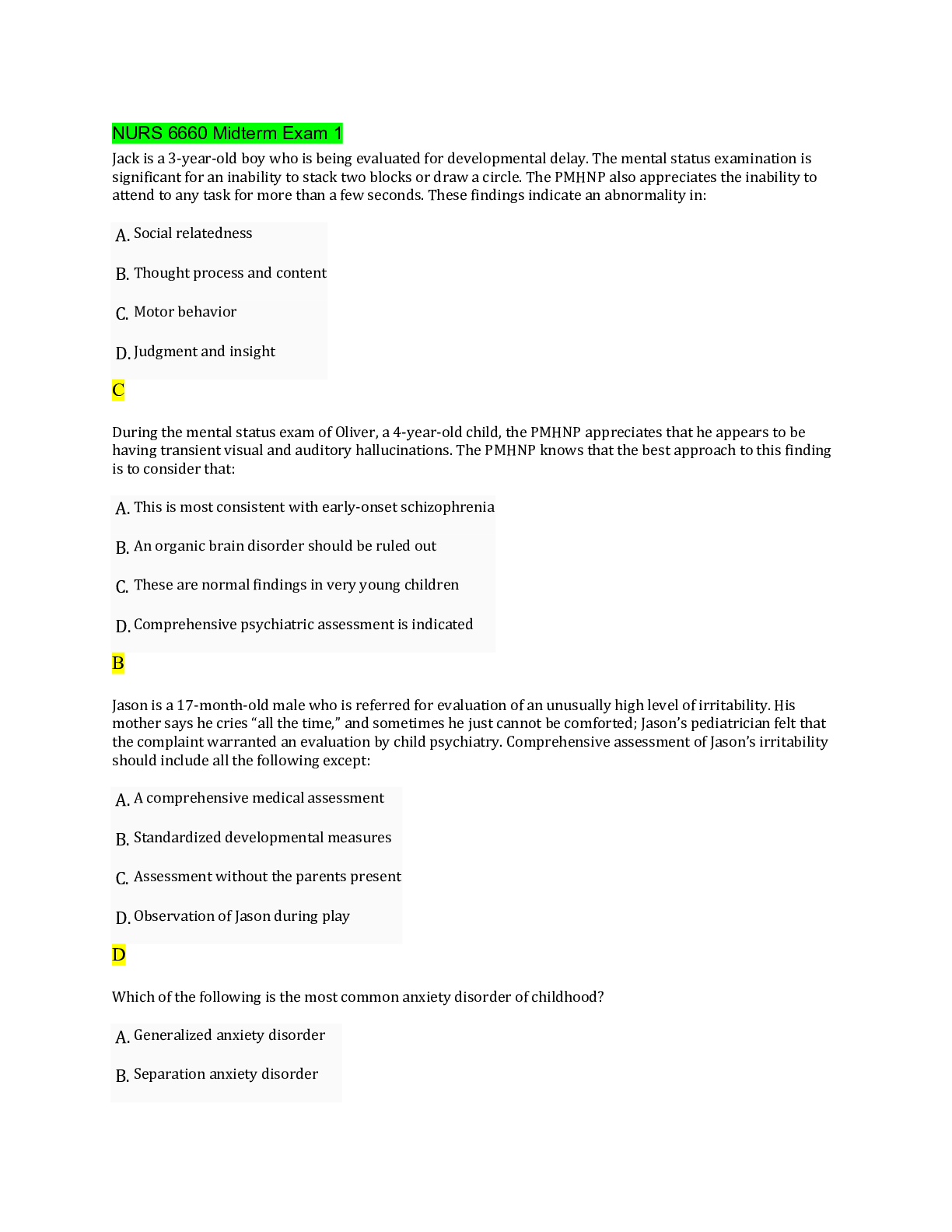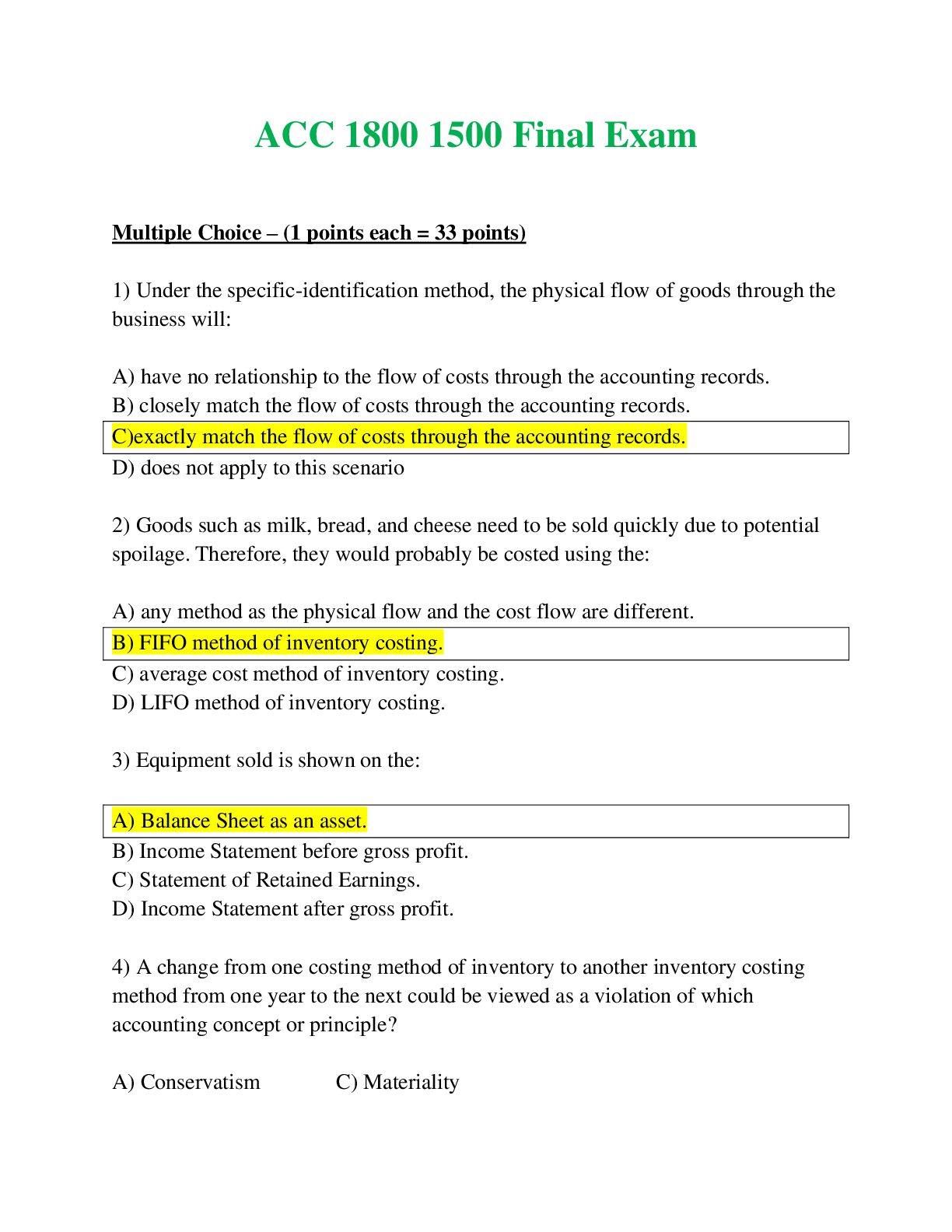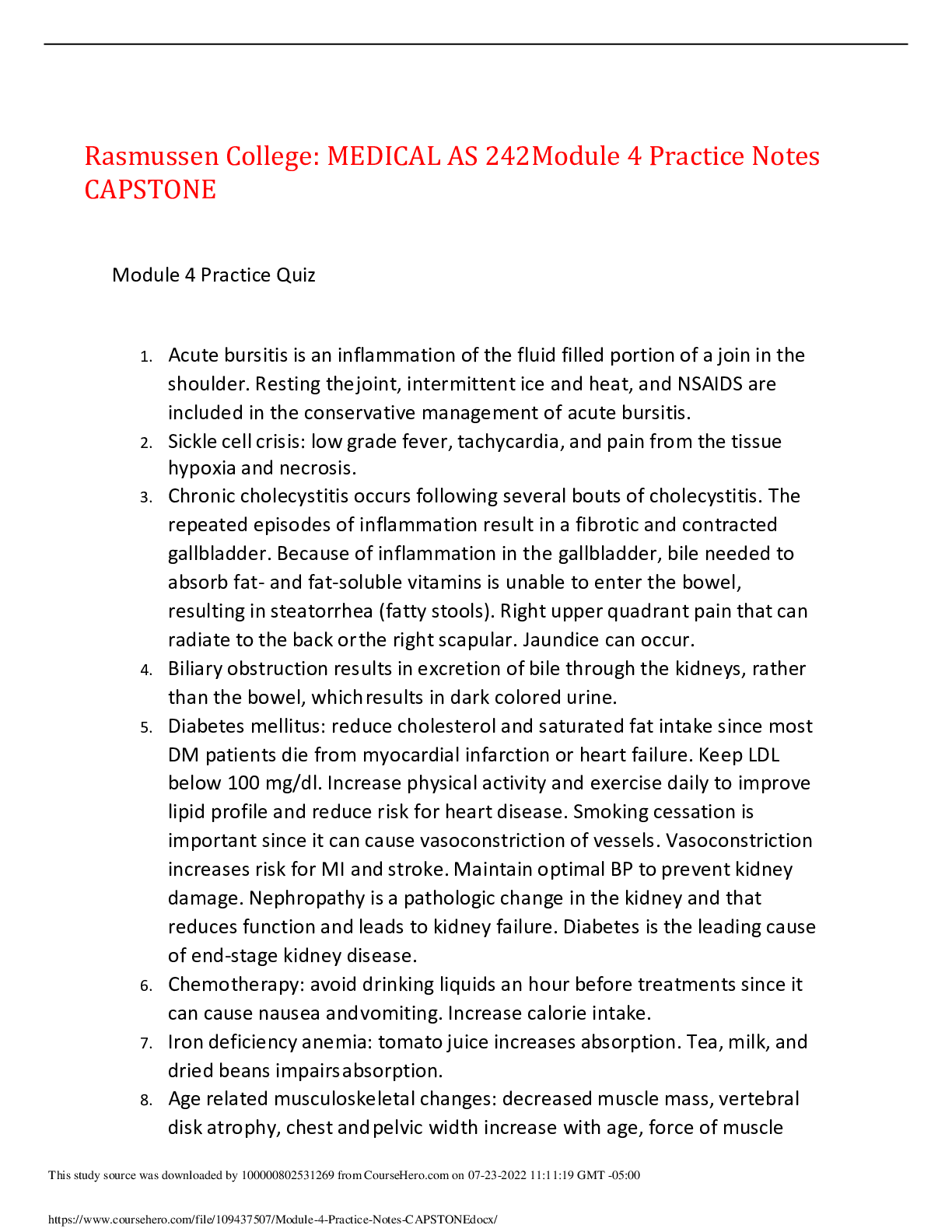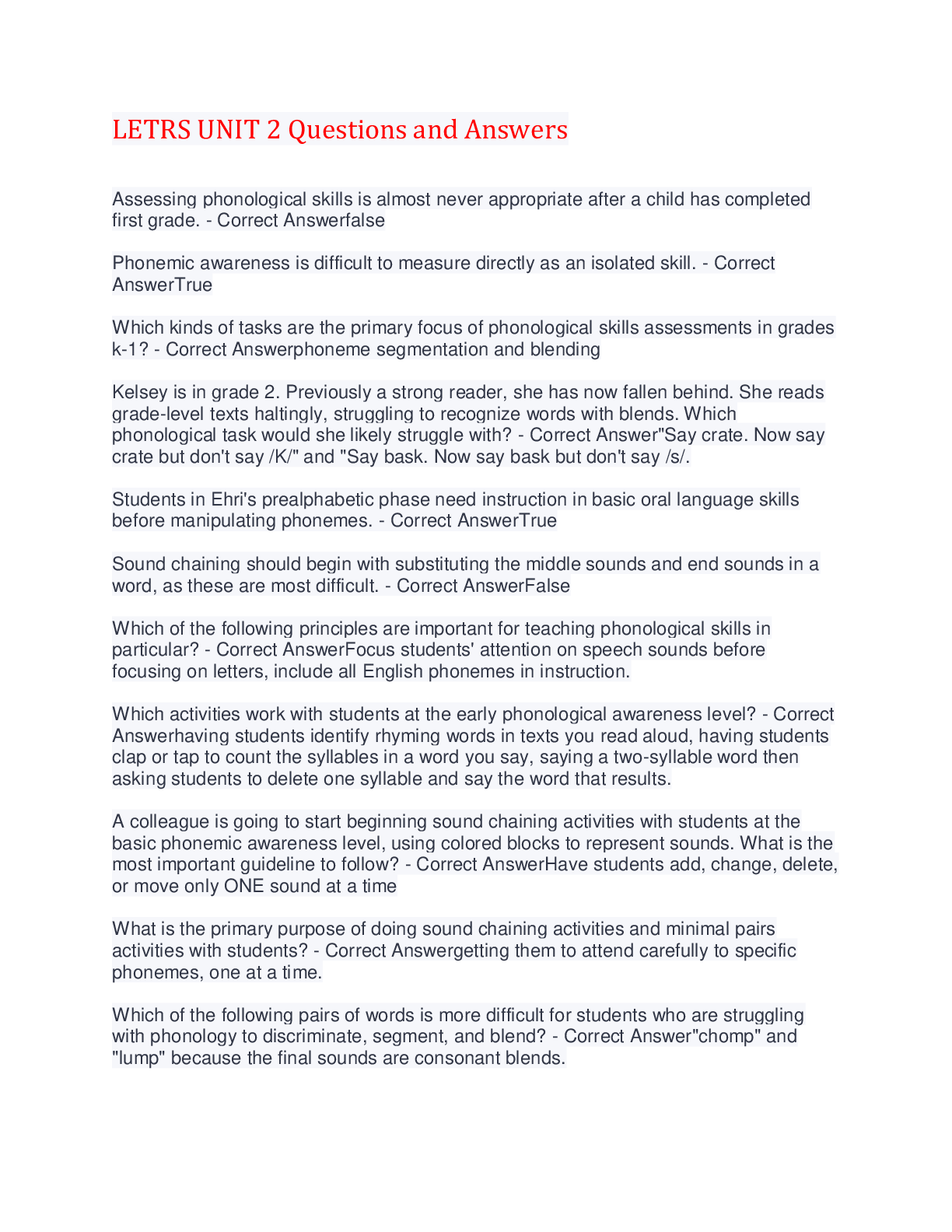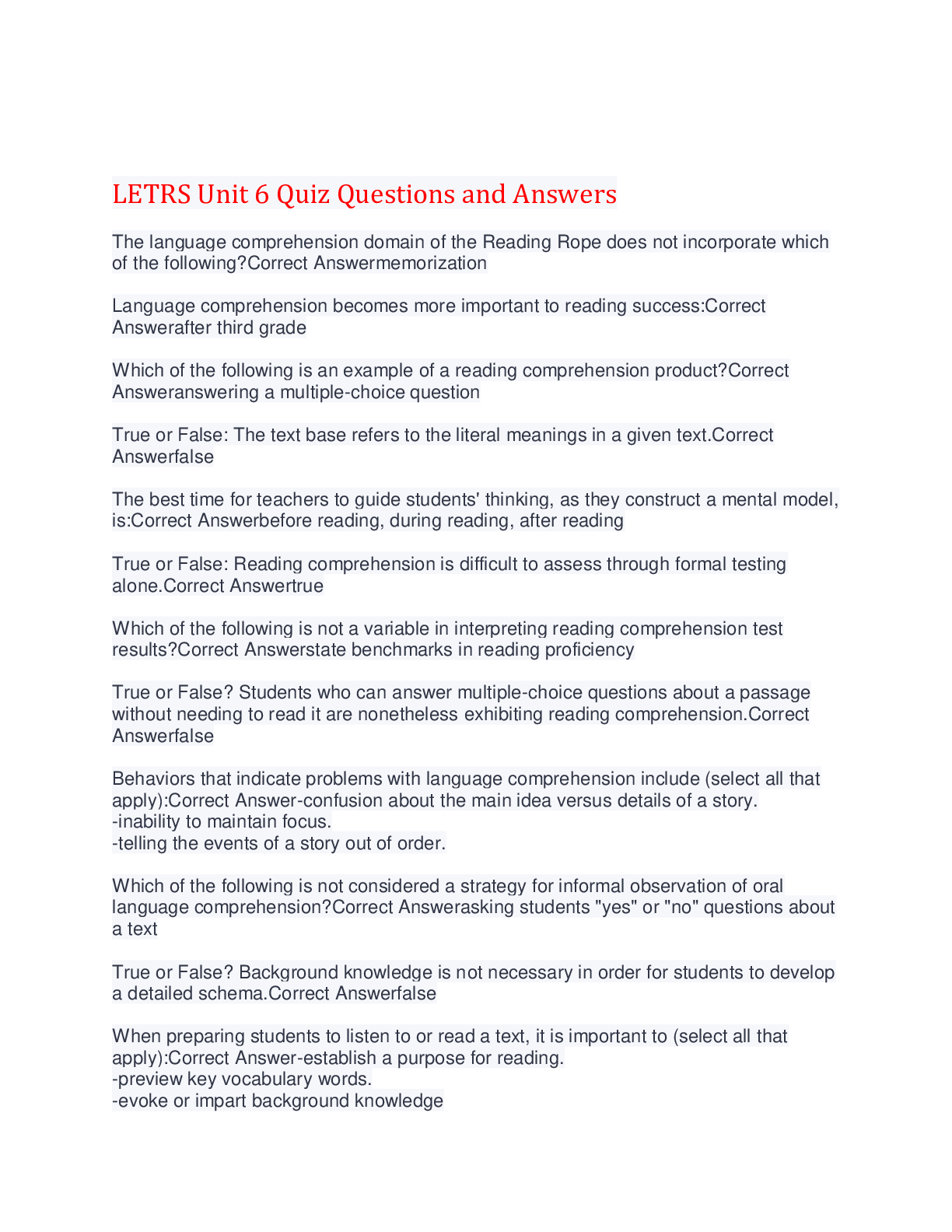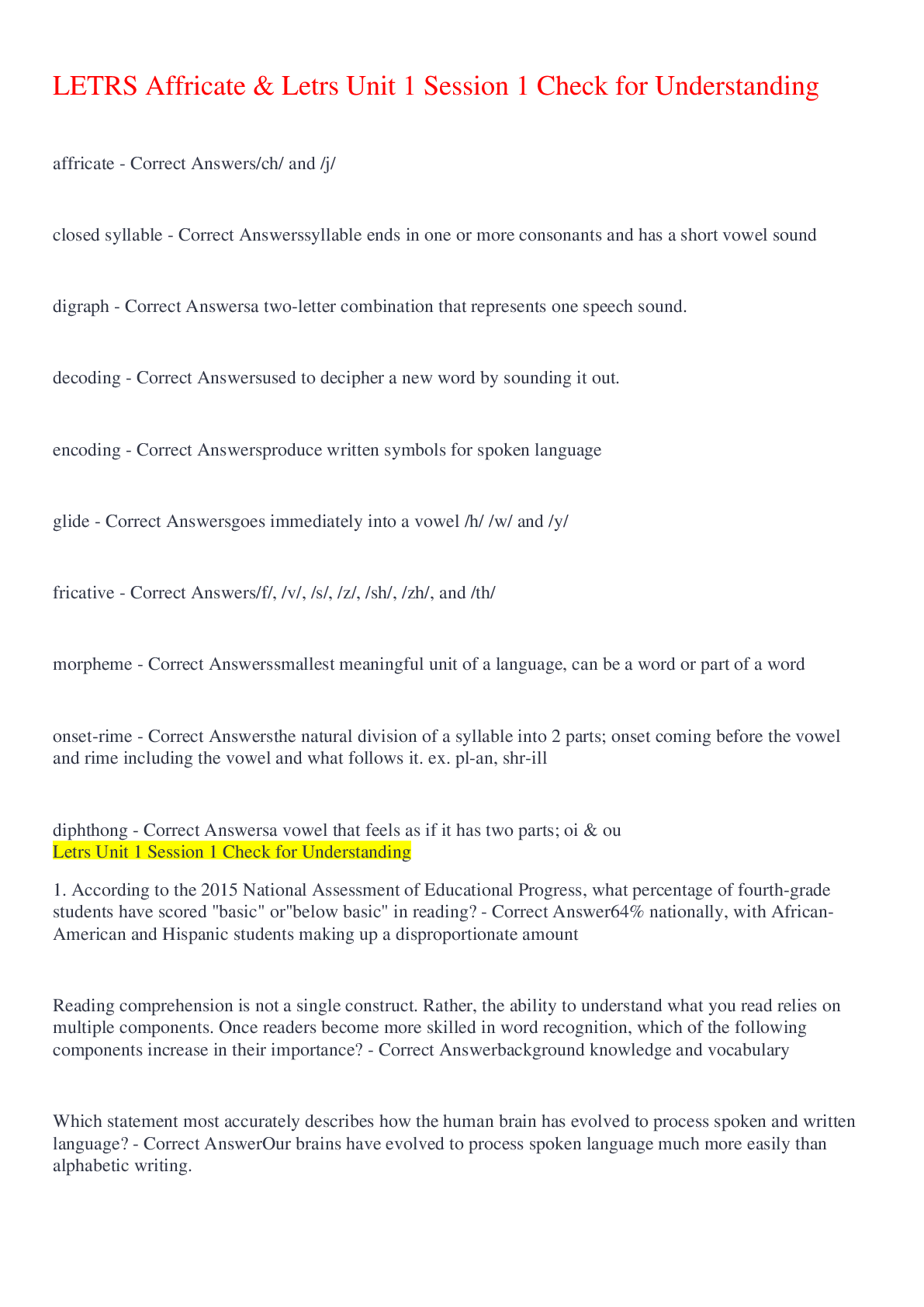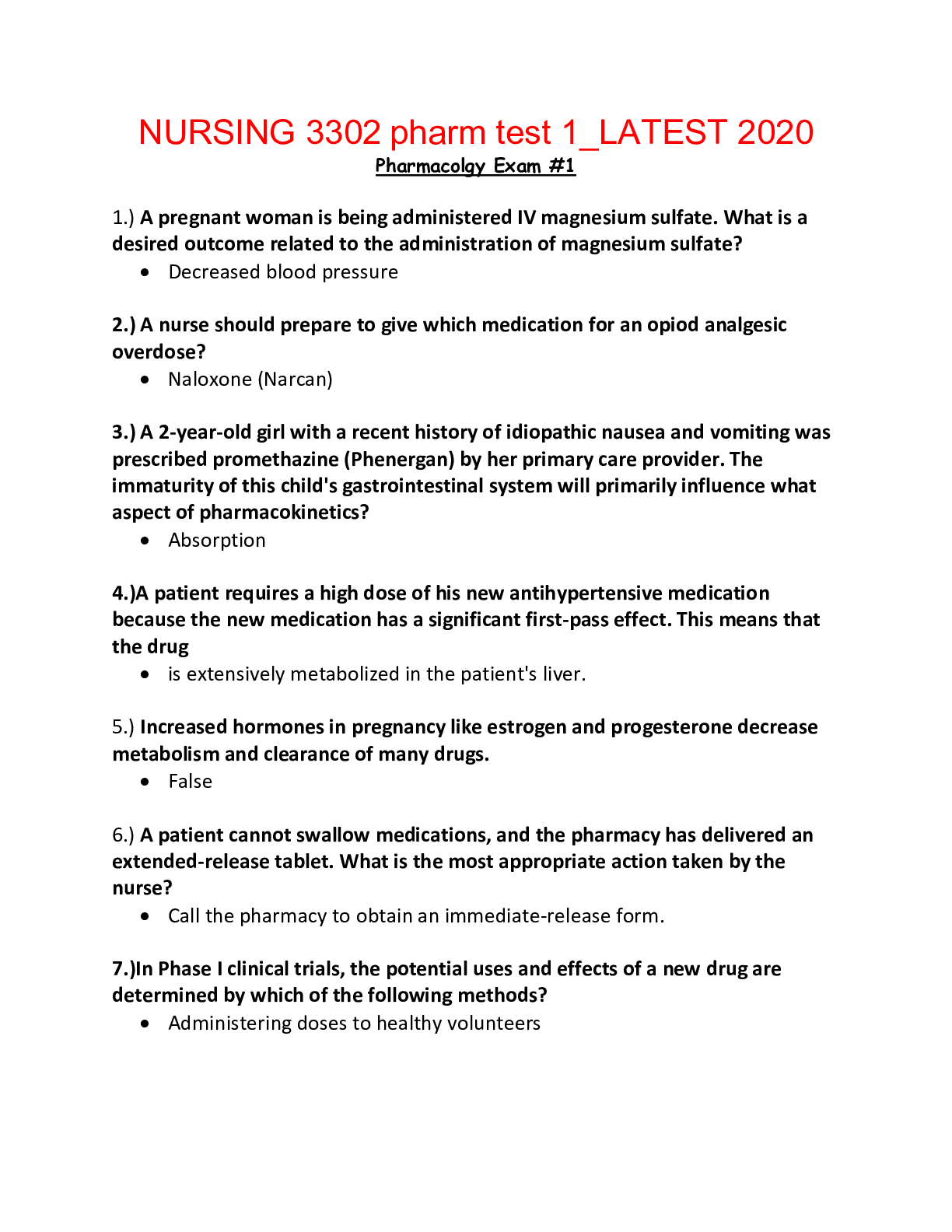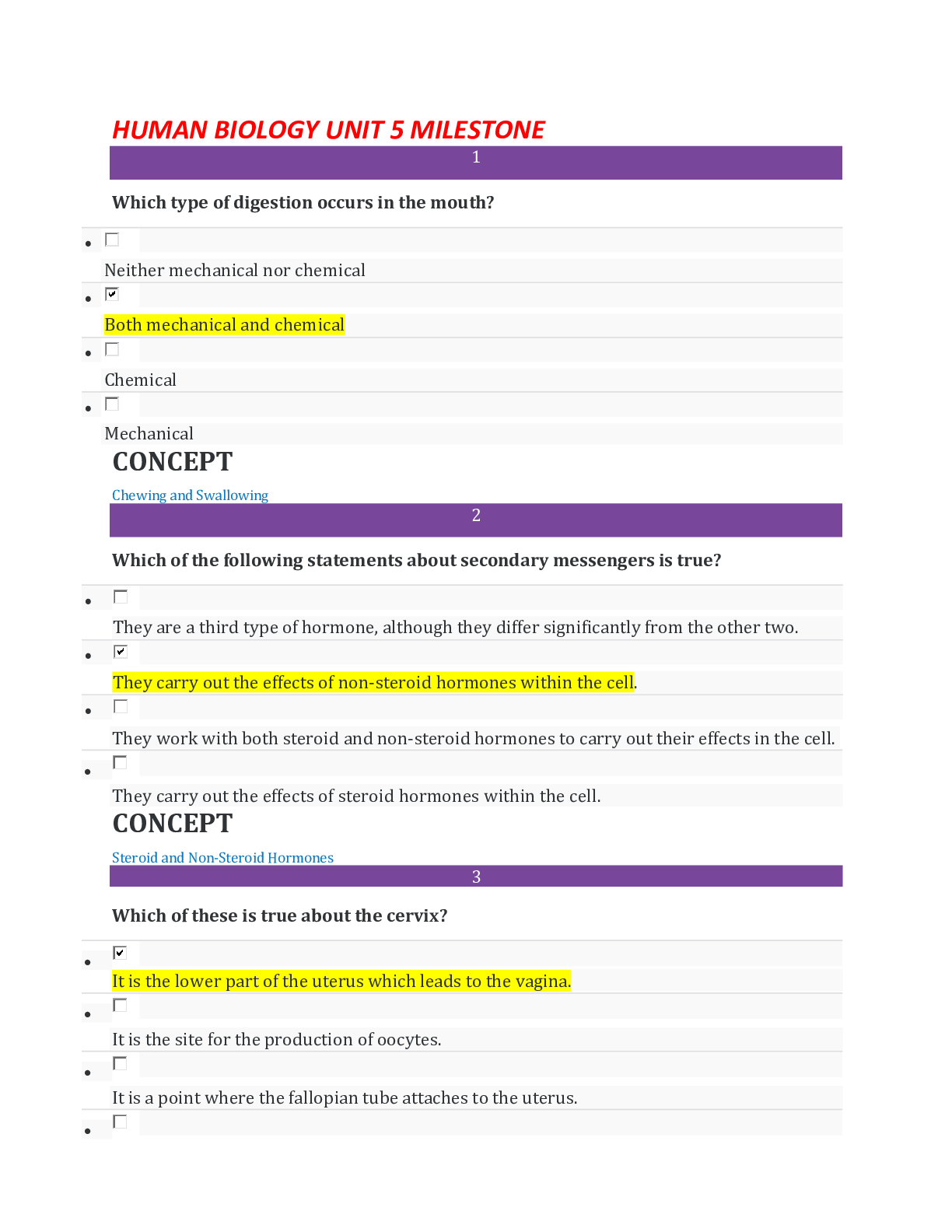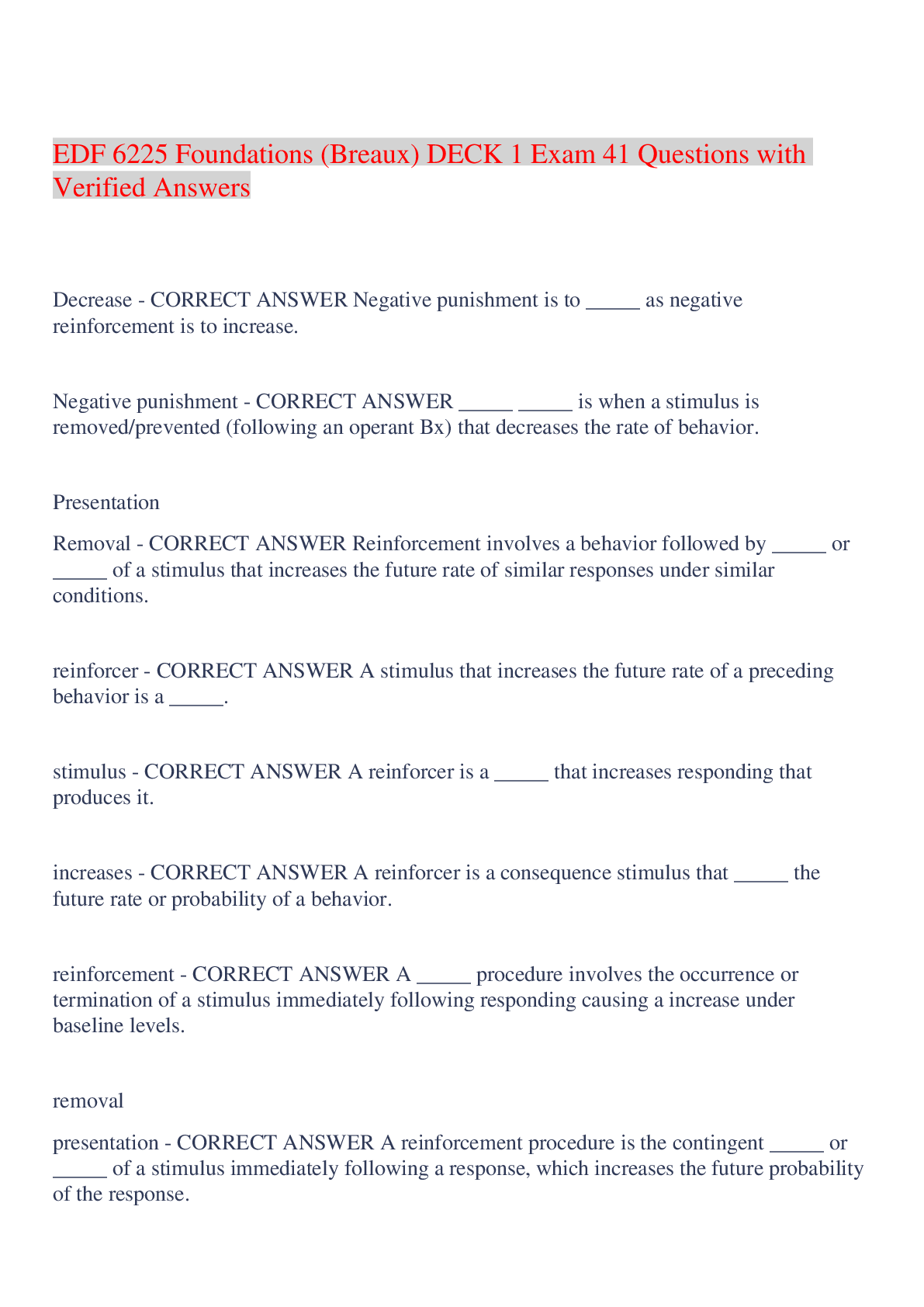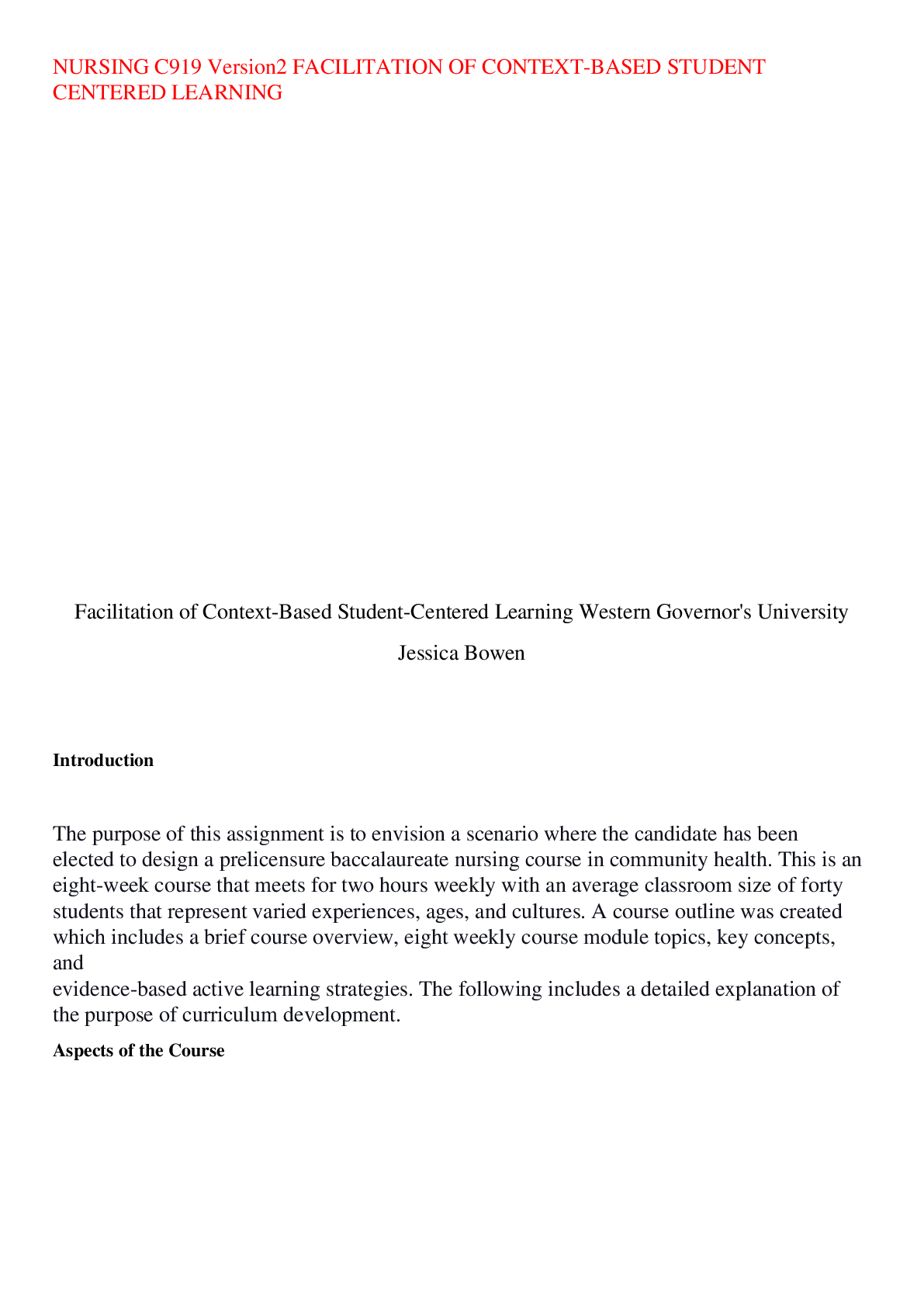*NURSING > EXAM > NURSING C919 Version2 FACILITATION OF CONTEXT-BASED STUDENT CENTERED LEARNING ,100% CORRECT (All)
NURSING C919 Version2 FACILITATION OF CONTEXT-BASED STUDENT CENTERED LEARNING ,100% CORRECT
Document Content and Description Below
NURSING C919 Version2 FACILITATION OF CONTEXT-BASED STUDENT CENTERED LEARNING Facilitation of Context-Based Student-Centered Learning Western Governor's University Jessi... ca Bowen Introduction The purpose of this assignment is to envision a scenario where the candidate has been elected to design a prelicensure baccalaureate nursing course in community health. This is an eight-week course that meets for two hours weekly with an average classroom size of forty students that represent varied experiences, ages, and cultures. A course outline was created which includes a brief course overview, eight weekly course module topics, key concepts, and evidence-based active learning strategies. The following includes a detailed explanation of the purpose of curriculum development. Aspects of the Course Students will benefit from enrollment and completion of the course as it will enrich their understanding of the needs of the communities in which they represent. While the focus on a number of nursing courses focus on patients in an acute setting, there are a majority of patients that are living in the community with chronic conditions and specialized needs. These individuals still may require nursing care on an outpatient basis. There is a growing need for community health nurses, and this course aims to provide a comprehensive introduction. The course begins with setting expectations of the students in the course as well as the students' expectations of the instructor. There is a review of the syllabus and an introduction to community health nursing, including the many roles of the nurse as well as the social determinants of health. Other topics covered in the course are community assessment, family assessment and cultural disparities, vulnerable populations and rural communities, Alzheimer's disease, chronic disease, mental health and substance abuse, communicable disease and infection prevention, and emergency preparedness. These topics cover key concepts such as identification of a community's patient demographics, differences in family dynamics, cultural views of healthcare, specific disadvantages of underprivileged populations, warning signs of abuse, importance of infection control, and emergency disaster plans. Throughout the course, best nursing practice strategies will be employed, particularly when discussing ways the undergraduate can learn to educate their future patients. Evidence- based practice is forever evolving, and it is important to stay current with research so that patients are receiving the best possible care. As described in the course overview, emphasis is placed on the nursing process to enable students to build upon their foundational nursing knowledge and supplement critical thinking skills while promoting the best nursing practice. Cultivation of Course The eight weekly module topics cultivate the development in the course in the sense that each topic begins to go in-depth for many aspects of community health. The first week begins with a review of the syllabus and the expectations that the teacher has of the students, as well as discussing what expectations the students have of the teacher. This promotion of a positive learning environment allows for student development that results in positive outcomes. The first class also includes an introduction to community health so that the students have a foundational understanding of what community health is comprised of. For any nurse to best understand what is required of them to serve their community, a comprehensive assessment must first be performed. The second session in this course will discuss what aspects of the community need to be observed and taken into consideration. The purpose and components of a windshield survey will be discussed, and that will be the take-home assignment for the students that week. The following week includes an assessment of the family, whether it is traditional or not, as well as differences in cultures and their outlooks on family dynamics and healthcare. Communities differ greatly in cultures and it takes a culturally competent nurse to be able to fully understand and respect the differences these cultures may have. As greatly as culture differs, so do healthcare needs for varying age groups and socioeconomic groups. The halfway mark through the course focuses on vulnerable populations, such as the elderly, children, underinsured, undereducated, and minorities. The course will focus on educating the students about different challenges these groups face, and ways to promote health and safety through education and community resources. Another group of individuals that require special attention is those living in rural communities, where a lack of physicians or transportation may interfere with their access to care. Progressing through the course, topics on Alzheimer's and other chronic diseases, as well as mental health and substance abuse are addressed with a primary focus on healthcare maintenance and education. Students will create concept maps for chronic diseases and their symptoms, treatments, and interventions, and then create a brief educational plan for a patient with a chronic disease. This aims to teach the student nurse to keep patients with chronic conditions out of the hospital and at home in the community where they would prefer to be. Strategies for identification of mental health exacerbations and substance abuse will be discussed, as well as the viewing of short films to help illustrate what an individual with a certain disorder may present as. A topic of particular interest as of current is that of communicable disease and infection prevention. The student nurse will be educated on the most common communicable disease, as well as prevalence rate, treatments, and levels of care (primary, secondary, tertiary) to avoid disease or reduce symptoms and spread of disease. The activity for this week will include a demonstration of adequate handwashing and personal protective equipment and indications of such. Additionally, the students will demonstrate proper injection techniques and safe sharps disposal, something that can come of use during flu season or while educating patients with newly diagnosed insulin-dependent diabetes. Rounding out the course is a session on emergency preparedness and disaster planning. This is useful particularly in areas of the country at higher risk for flooding, hurricanes, tornadoes and other natural disasters. This course will assist the student nurse in understanding priorities when a disaster hits, as well as helping develop a contingency plan for potential evacuations. Student-Centered Learning This course is geared towards student-centered learning because it maintains an all- inclusive outlook on differences in communities and the individuals they represent. By doing so, the emphasis is placed on the idea that every nursing student is an individual in their respective communities. The students enrolled in this course are adult learners, and the instructor must be aware that these learners are more capable and self-directed than child students. These adult learners prefer to know why they are learning particular content, and ideally want to learn what they can start to apply in their everyday life. A well-organized classroom focuses on different generations and cultures and lays out ground rules and expectations at the initiation of the course. This is why the first class is spent with a review of the syllabus, as well as setting expectations of one another. Another useful tool that the instructor will use is to ask how the individual student learns best, whether it be auditory, visual, or kinesthetic. Every individual learns best in different ways. This is why the course was developed with various active learning activities, in an attempt to engage the various domains of learning. Every class session will involve a group discussion, where there will be a reduction of anonymity and greater inclusivity for the input of the classroom. This will enable students to ask questions for clarity, and allow the instructor to gauge the level of understanding of the students. This also provides the student with near-immediate feedback of their own understanding, which further fosters a positive classroom environment, and thus positive student outcomes. Much how nurses participate in patient-centered care, where the patient is the center of creating a care plan, student-centered learning is similar. Students are the center of how they learn. While the educator is ultimately responsible for imparting knowledge and sticking to the curriculum to meet the course outcomes, the educator must also facilitate the students as they take charge of their own learning. The weekly concepts have been carefully selected to appeal to the various learning style preferences, in the educators best attempt to reach every type of student in the classroom. The nurse educator must deliver the lecture in a way that the student is then able to independently manage their newly acquired knowledge and apply it to the weekly concepts, further encouraging a student's self-efficacy. Professional Standards and Guidelines The key concepts in the course outline appeal to student-centered learning, because they will be taking away information that will directly apply to their role of community health nurse. These will be useful and practical concepts that will keep the student motivated and active in their learning. The Quality and Safety Education for Nurses (QSEN) is a very important topic in the field of nursing, because it represents the need for nurses to continue researching best nursing practices as it applies to quality and safety standards. In order to achieve this, QSEN has created competencies with six general focus areas. These focus areas are: patient-centered care, evidence-based practice, teamwork and collaboration, safety, quality improvement, and informatics. The first class meeting has the key concept of the role of the community health nurse. This relates to the QSEN competency of teamwork and collaboration, because the student will acknowledge the various roles they play as community health nurse, and how those roles are expected to collaborate with other disciplines and resources in the community. The second week key concept is for the student to accurately identify patient demographics, resources, and needs. This aligns with QSEN's competency of both teamwork and patient-centered care, as it allows the student to integrate understanding of the multiple dimensions of patients, such as their preferences and values. The student can also identify various needs and resources that would require the help of other disciplines. The third week concept focuses on assessment of the family and cultural disparities throughout the community. The student will be able to identify differences in family dynamics and cultural differences, as well as develop a keen eye for potential domestic abuse situations. The QSEN competencies that aligns to this concept are those of patient-centered care and safety. It is important for the student nurse to begin to realize that all cultures have different beliefs and varying personal values when it comes to their health, and that the patient is at the center of determining the care that they receive. It is also very important for nurses to keep patient safety a top priority, particularly when dealing with potential domestic abuse situations. Midway through the class marks the fourth key concept, where the student identifies difficulties in disadvantaged populations, such as those individuals living in rural populations with little access to resources, low income families, and those with lower educational status. Again this aligns with the patient-centered care, safety, and teamwork competencies, because it requires the student nurse to understand what resources the patient is working with, what is important to the patient in terms of their health status, and collaborating with different disciplines to give the patient the safe and quality care they deserve. The fifth key concept is the one that appeals to all six of the QSEN competencies, and that is the concept of patient education for management of chronic disease. Nurses are educators, even if they are not nurse educators, and it is imperative that they allow the time to teach their patients the best ways to care for themselves, particularly in the community. As previously mentioned, this requires patient-centered care, teamwork and collaboration, and safety. However, now also the additional competencies of evidence-based practice, quality improvement, and informatics are present. This is so, because it is important for the nurse to share the most current and best evidence-based practice methods for symptom management and chronic disease maintenance. Furthermore, if the outcomes of the care processes currently being used by the patient are not working optimally, the nurse can then utilize quality improvement to determine better ways for the patient to manage their conditions. Management of symptoms for conditions such as congestive heart failure, may require daily monitoring of vital signs and weights, using equipment that can remotely transfer data to a visiting nurse organization. Telemedicine is becoming more prevalent in today's society, so the nurse would have to also educate patients on how to use informatics as well. The key concept described in the sixth week of the course pertains to substance use and mental health. These topics were grouped together, as they tend to go hand-in-hand. The main points of these topics allow the student to identify if a patient is struggling with mental health or substance abuse, and naturally the resources available to them in the community for additional support. Again, keeping in the apparent theme of the course, these competencies are aligned with patient-centered care, teamwork and collaboration, and patient safety. Patient safety is a priority when dealing with patients who struggle with mental health disorders, particularly if they are not managed appropriately, as their behaviors can be erratic and cause potential harm to themselves or others. Additionally, substance abuse is a huge safety issue in regards to potential overdose or driving a vehicle under the influence. The penultimate week of class brings about the discussion of infection control and safety, such as communicable disease and proper sharps disposal for patients who may be insulin dependent or require short-term anti-coagulation therapy. Evidence-based practice and safety are two predominant competency themes for this week's concepts. Just as with the chronic disease topics, current best evidence-based practice is what nurses strive to teach their patients, and as always it is important to keep the patient and their family's preferences at the center of the care planning. Finally, the closing week of the class focuses on natural disasters and emergency planning. This concept aligns with the competencies of teamwork and collaboration, as it is very important to maintain an open line of communication when dealing with emergency preparedness. This is particularly relevant in times of natural disaster and global pandemic, as the public has a tendency to panic unless there is strong leadership in place to get them through the situation with a well organized plan. Quality improvement comes into play as well, because every situation can serve as a learning opportunity to find parts of the system that could use improvement. Again, above all else, patient safety is priority, so it is important to have a solid plan that is well organized so that the patients can have the best possible outcomes. Alignment of Weekly Key Concepts to Overview The weekly key concepts are strongly aligned to the course overview because it succinctly mentions the topics that will be covered throughout the course, as well as the expectations of the student nurse in terms of applying the nursing process throughout each topic covered. The weekly topics and concepts are part of a comprehensive introduction to community health, with emphasis on identification, assessment, and evaluation of cultural and family differences, vulnerable populations, chronic disease, mental health and substance abuse, infection control, and emergency preparedness. The student nurse is expected to learn accurate identification and assessment of each topic, as well as developing their own educational plan and interventions. Course Outline Relevance The National League for Nursing (n.d.) lists core competencies for nurse educators, one being that the nurse educator will participate in curriculum design and evaluation of program outcomes. The NLN goes on to describe that nurse educators are responsible for both creating a course design (outline) and designing the curriculum that reinforces current health care trends and prepares the student nurse to be effective when operating independently as a registered nurse. Nurse educators are nurses who obtain advanced degrees specifically designed to equip them with teaching nursing curriculums. Creating a course outline is relevant to the role of a nurse educator through the scholarship of teaching. One goal in designing a course is for an educator to understand how students learn best and which practices help to foster that learning. Nurse educators are responsible for designing, implementing, and evaluating nursing curriculums because they are most up to date with evidence-based practice and understand the importance of instilling critical thinking skills in future generations of nurses. Learning Strategies A learner-centered approach is preferable when preparing lessons because it is the responsibility and priority of the educator to promote effective teaching to the students. Ideally, a nurse educator would keep in mind the differences in student culture when designing and teaching a course. To do this, the nurse educator must consider that their students not only come from different backgrounds and life experiences but from different cultures and different learning style preferences as well. For a nurse educator to determine the best learning strategies to use, it is first important to understand the different types of domains of learning and learning style preferences. Overall, there are three domains of learning: cognitive, affective, and psychomotor. The cognitive domain involves individuals who learn best by thinking. This cannot be directly observed but can be seen through behaviors such as writing short essays and developing course materials. The affective domain involves values and beliefs, which still cannot be directly observed but are best seen through an individual's attitudes, behaviors, and choices. The psychomotor domain involves skilled movements, which are directly observable by the educator. Both the affective and psychomotor domains are more easily recognized in the nursing field. While there are many models of learning style preferences, perhaps the most popular and widely recognized model is the VARK Learning Preference Model popularized in 1992 by Fleming and Mills (Oermann, De Gagne, & Phillips, 2018). This is the introduction of four learning style preferences: visual, auditory, reading/writing, and kinesthetic. The visual preference best receives information in the style of maps, charts, and other pictures versus text formats. The auditory learner best learns when they are receiving information through language. The reading/writing learner prefers information to be relayed through text and note-taking. Kinesthetic learners are inclined to like information presented in a concrete and experience-based format, such as physically moving and performing the skill at hand. With learning domains and style preferences being taken into consideration, the nurse educator can efficiently design a curriculum that can appeal to any student. Unfortunately, not every topic in an eight-week course can be tailored to fit every single learning style given the time constraints, but the educator can try to reach the full audience to the best of their ability. In this community health course outline, evidence-based active learning strategies are listed as they relate to the weekly topic. Every week includes a lecture followed by an instructor-led group discussion pertaining to the main topic to help the students thoroughly understand the key concepts. Group discussions help to engage active learning, are best used in small groups, and allow students to build ideas off of one another. The old saying goes that there are no dumb questions and that if one student has a question about a topic there is a high likelihood of another student also having the same question. It is important for the educator to then become the facilitator, helping students establish dialogue while assessing their level of understanding of the topic. Another learning strategy found within the course outline is self-reflective journaling and the windshield survey. This appeals to those students who find themselves in the cognitive domain, and are best for independent learning. This is found in the first two weeks of the course, with a journal entry done by the students in regards to their self-views of which role they feel they currently best identify with and which roles they may wish to better develop. The second week of the course involves the windshield survey, which allows the students to step out into their community and evaluate every aspect of it from a nursing perspective. A third learning strategy is the assignments of developing a culture outline, creating a concept map of a chronic disease discussed in the lecture, and creating an educational plan for a patient based on the concept map. These assignments help strengthen a student's critical thinking independently while appealing to the affective and psychomotor domains of learning. The cultural difference outline helps create a culturally competent environment and reminds the students to be mindful regarding differences in healthcare views throughout variations in culture. The concept map helps a student link a diagnosis with clinical symptoms and interventions the nurse can anticipate. The patient education plan helps prepare the student nurse for one of the most important aspects of community health nursing: education, prevention of exacerbations, and subsequently prevention of hospital readmissions. Implementation of Learning Strategies As the chronic disease concept map and correlating educational plan are intended to be a take-home assignment for the students, the implementation of said strategy is simple. Initially, the students must attend the lecture for that week so that they are aware of the chronic diseases they will ultimately be responsible for on the final exam. The nurse educator is responsible for explaining the directions and purpose of the assignment, including why assignments like this are important for their future careers as nurses. This assignment appeals to the cognitive and affective domains of learning, as the thought processes and rationale that go into the assignment can not necessarily be directly observed, but reflect critical thinking, clinical knowledge, and the values and beliefs of the student nurses and the patients. The concept map and educational plan assignment have also been implemented to address various learning styles as well. Initially, the lecture on chronic disease appeals to auditory learners, as they learn best by listening. They are also encouraged to write notes and read supplemental textbook chapters on the chronic diseases of their choice, which appeal to the learners who best benefit from reading and writing. Visual learners may benefit from their creation of a concept map, because they may be able to better memorize information once their map is finished. Unfortunately, this assignment does not necessarily suit those who learn best by physical demonstration, but it is difficult to find an assignment that perfectly fits every type of learning style. Assessment of Learning Needs and Styles One of the learning strategies from the course outline that may have the broadest impact on the class is that of the chronic disease concept map and educational plan. While this is more geared towards independent learning, it involves knowledge that is taken directly from the lecture and group discussion regarding chronic disease and requires the student nurse to employ their critical thinking skills to ultimately develop an educational plan for a patient living in the community with a chronic disease. In the classroom setting, the concept map and educational plan is geared predominantly towards the cognitive domain of learning, asking the student to think about what is clinically important to recognize about a chronic disease, and then applying what would be important goals for the patient to meet, including behavioral and lifestyle modifications for disease management, alleviating symptoms and reoccurrence of exacerbations, thus improving patient efficacy and reducing the need for hospital readmission. After graduation, these students become registered nurses operating independently on their own licenses, and the skills learned through concept mapping and creating an educational plan will actively be demonstrated by educating their patients. Concept mapping and creating the educational plan, although two physically separate assignments are active learning methods that require the student to become participatory. These assignments are justified in clinical reasoning, as they directly pertain to a nurse's responsibility not only in community health but in overall nursing practice. Regardless of the setting, patient education is a large component of what nurses do on a daily basis. These activities also allow the student an opportunity for self-reflection, as they may be able to evaluate their own level of understanding of a disease process, or they may relate a chronic disease to one of their own family members. The student will also reflect on their own attitude and what values they have when working with a patient to determine personal goals. Clinical Reasoning and Self-Reflection Skills The concept map and educational plan facilitate the development of clinical reasoning in that it allows the student nurse to zero in on one common chronic disease and really focus on the signs, symptoms, and other pertinent information to help them in their careers as nurses. Standard lectures involve regurgitation of facts that students can commit to memory. However, nurses need to be able to integrate and connect pieces of information together in order to be able to decide the best course to take based on that information. With a concept map, the student is then able to take one broad topic like a chronic disease, and break it down into symptoms, treatments, preventative measures, and nursing interventions. This allows the student to look deeper into potential causative facts that relate to the disease, strengthening their critical thinking and clinical reasoning. The concept map and educational plan could also strengthen self-reflection. Higher education students come from diverse backgrounds, including different life experiences. Some of these students may have a background in healthcare in one form or another or may have family members who are living with a chronic disease discussed in the lecture. This may resonate with some students, allowing them to reflect upon their own personal lives. For my own self, I was in my final year of nursing school when my grandfather was finally diagnosed with congestive heart failure. Despite following all medical advice and living within strict guidelines of heart failure management, his heart was already too poorly damaged from a past history of heart attack, and he died from cardiogenic shock within five months of diagnosis. As a nursing student myself, particularly doing an advanced medical-surgical rotation on a heavy cardiac floor at a local hospital, I became more in tune with symptoms that displayed an exacerbation of heart failure, and I knew ways that my grandfather took care of himself at home. These ways included daily weights, medications, low sodium diets, fluid restrictions, checking for edema or jugular vein distention. I was then able to take that personal experience with me as a new graduate nurse, working in a skilled nursing facility. Currently, I primarily work in geriatrics and deal with patients living with chronic conditions on a daily basis. Being able to see a chronic disease in a human being and knowing everything that goes into managing their care at home is like a real-life concept map and educational plan. You see the umbrella term of a diagnosis, followed by the symptoms that exacerbate the condition, along with everything that goes into managing it safely. This assignment creates the experience that deepens self-reflection, clinical reasoning, and critical thinking. Learning Environments In today's age, there are a number of various settings in which higher learning can take place. There is the traditional classroom setting, in which students travel to a college setting and sit in a classroom for a lecture. Online-based universities are becoming increasingly popular, creating greater accessibility for adult learners who have families and full-time jobs to work around. All undergraduate nursing programs also have a clinical component to them, where they travel to a clinical agency under the supervision of a nurse educator faculty member and train among a more "real-world" scenario. Regardless of the learning environment, it is the duty of the nurse educator to remain focused on the student and foster student-centered outcomes. It is also the duty of the nurse educator to ensure the promotion of interprofessional collaboration and teamwork. Strong teamwork and collaboration between disciplines lead to increased respect among colleagues, better self-awareness and ultimately self-evaluation of the strengths and weaknesses of an individual, better communication skills, more accountability, and higher motivation. It is important for an individual, particularly a healthcare worker, to be able to have an open line of communication with other disciplines, as patients need to be viewed as a whole, and it takes a team full of nurses, doctors, therapists, dietitians, and even housekeepers and janitorial staff, to deliver safe and high-quality patient care. For a nurse educator to begin fostering student-centered outcomes, the educator must set clearly defined rules and expectations of their learning environment. The nurse educator must hold every student accountable for his or her own actions, and to firmly and quickly put an end to disruptive and disrespectful behavior. The student-teacher relationship must also have open communication and mutual respect in order to work efficiently. The nurse educator must also assess a student's level of participation, and preferably identify their preferred learning style early on in the semester. This will allow the nurse educator to mold assignments to each student in the best way to help each student maximize their potential. Most commonly, nursing programs take place in the physical traditional classroom setting. The very first class is when the instructor should set her expectations and thoroughly explain the course outcomes. In a physical setting such as this, the main roles that are able to collaborate with one another are that of the student and that of the teacher. It is important for the students to be present and respectful of their instructor and listen to what it is that the instructor is portraying in class. It is also imperative that the instructor is respectful of the students as well and is in tune with the individual needs of each student. Building a strong rapport in the classroom leads to interprofessional collaboration and teamwork, and thus greater student outcomes. The online classroom environment is a bit trickier, as there is not always the option for a face to face meeting. Some universities offer hybrid programs, where half of the learning is done online and the other is done at a campus. However, for the intents and purposes of this paper, a fully online program will be evaluated. Again, the main roles displayed in an online setting are that of the students and that of the instructor. Some universities also offer a program mentor, who is an expert on the overall program of study versus the individual class. The program mentor works with students on a more personal level while offering their professional advice and guidance as well as monitoring their academic progress. Generally, students will work with a program mentor before starting their courses, creating a stronger rapport that will last them throughout the term. For strictly online learning environments, the role of nurse educator may prove to be a bit trickier when it comes to creating a meaningful and trusting relationship. Students in an online program are generally expected to learn on their own with the resources provided to them, in a more self-directed manner. They have few deadlines given to them, but no traditional classroom hours or lectures to attend. The nurse educator of an online university has unique obstacles, as they are required to find educational resources that appeal to various learning styles. The nurse educator should also foster student-centered outcomes by maintaining an open line of communication, posting and adhering to "office" hours, and reaching out to students on a semi- regular basis to ensure that the students are making sufficient progress. They must be prompt with responses to e-mails, and frequently be available for phone calls as well. Another obstacle in the online setting is that it is difficult for a nurse educator to fully assess the learning styles of each individual student. This is why it is important for them to find plentiful and diverse resources to appeal to various styles. The nurse educator in both face-to-face and online classroom settings must provide the student with ample resources to succeed in their degree program. This includes access to services such as library, IT, financial assistance, writing centers, and other student success centers. These resources are full of employees from other disciplines that collaborate as a team to give the student the greatest chances of success. One way the course instructor could promote teamwork in a face-to-face classroom is to break down the classroom to complete assignments in small groups. This requires students to work with other personalities and leadership styles, and will get them accustomed to working with others to achieve a goal. A course instructor at an online university could promote teamwork and collaboration by having forum posts for weekly discussions, and part of the grade could be for students to complete meaningful replies to other students forum posts. Online universities could also offer live cohorts that students could attend, with a chat function for better communication and collaboration. As mentioned earlier, all undergraduate and some graduate nursing programs have a clinical component. The clinical setting allows students to take theoretical knowledge learned in a traditional classroom setting and apply it to real-world scenarios while dealing with patients. All universities have legally binding contracts with clinical agencies, and there are clearly defined roles and responsibilities that faculty and students must adhere to while practicing in this setting. The clinical agency is still primarily responsible for the care of their patients, and they maintain the right to revoke practice of any student or faculty member who is operating unsafely. In a clinical setting, teamwork and interprofessional collaboration are easier to identify. Working in a hospital setting, there are already many disciplines within arm's reach. The student will be able to directly observe how doctors and nurses work alongside patients, as well as therapists, dietary staff, housekeeping, and even other clinical students. More than in any other setting, an open line of communication, as well as trust and respect, are crucial in order for operations to run smoothly at a hospital. Any breakdown in communication, no matter how minor, can potentially lead to detrimental and devastating adverse patient events. Every discipline must understand that they are ultimately working together for the better of the patients. Allowing clinical students to observe this teamwork and camaraderie in a real-world setting can set the stage for how they will be expected to work when they are registered nurses. It is also the responsibility of the nurse educator to facilitate the experiences students have in clinical settings. The nurse educator must choose patients that have conditions pertinent to the topics being taught in the classroom setting. These patients must also be appropriate for the student's current skill level. As in any situation, the nurse educator must also set clear expectations that these students are not currently operating under their own license, and hospital- specific policy and procedures, as well as individual university expectations, must be strictly adhered to. On occasion, a nurse educator may even assign two students to one patient, to build upon professional communication and collaboration. Nursing Students' Experiences No two students are the same, regardless of age or educational level. Particularly in higher education, diversity among students is large. Gender, socioeconomic level, and cultural background have the biggest influence on their willingness and ability to learn. These three factors also play a role in how people interpret their experiences and how they react to health and illness. Cultural competence is a topic that is taught in most undergraduate courses, so it should not be a novel concept for the nurse educator. However, it must be slightly tailored to fit the role of students versus patients. The United States has long been considering the melting pot of nationalities. There is a growing number of culturally diverse students entering higher education classrooms, with a projected estimate that the minority population will increase to more than half of the nation's population within the next forty years (U.S. Census Bureau, 2012). In order for nurse educators to keep up with the increasingly diverse student body, there needs to be a strong knowledge of the values and beliefs of specific groups. It is also important for the nurse educator to maintain the expectations of western medicine and how the United States is legally required to practice. Men and women have differences in how they act, react, and perform in situations. There are both structural and functional differences between the genders, though there are still arguments in nature versus nurture domain. Females are more verbal and intuitive and are able to pick up on tones of voice and facial expressions while having a tendency to excel in languages and verbalization. Men, however, have stronger senses of direction, spatial abilities, and quantitative reasoning skills. Females also demonstrate higher accuracy during memory recall, but men have slightly faster reaction times. While there are observable differences in strengths and weaknesses between the genders, many are still unsure on whether they differ in general intelligence. It is also important to note that the genders are parts of different social cultures as well, using different symbols and belief systems, much in the way that different ethnic groups do. A student's socioeconomic status is a critical determinant of a person's mental and physical health. The socioeconomic status is essentially an individual's social standing, mostly relating to income. With low income typically comes a low educational level, as these people may be forced to drop out of school to get a job so that they can help provide for their family. Socioeconomic status comes from many different ethnic groups and varies throughout the country. There is a cause and effect relationship between low socioeconomic status and low cognitive ability, along with poor physical and mental health, and ultimately a worse quality of life. In the world of nursing, it is important to recognize that these individuals from lower- income levels and poorer neighborhoods are also at higher risk of uncontrolled chronic diseases and a lower life expectancy. In the same vein, individuals with a higher income and higher educational level have a tendency to live longer and healthier lives. People from lower socioeconomic classes also have a more pessimistic view of life; that they are powerless and meaningless, and are indifferent to the symptoms of illness until it begins to impede their daily lives. In order for a nurse educator to successfully teach students of lower socioeconomic status, they must take into consideration the student's less than average cognitive functioning, low literacy, higher susceptibility to illness related to increased levels of stress, and inadequate social support. The nurse educator should also note that these students may have lower self- esteem and lower attention spans, requiring more frequent validation and quicker feedback. These students have a great number of obstacles to overcome, and the nurse educator should be sensitive to these needs and try to be accommodating (Bastable, 2019). To be an effective nurse educator, one must ensure that they are running a gender-neutral classroom, free of stereotyping and generalizations and that they are open-minded to the different belief systems of the diverse students they are teaching. The nurse educator should call upon student's various life experiences and encourage them to use it to help and guide the students in their own practice. Learning Theories Just as there are many different domains of learning and learning style preferences, there are various learning theories that can help an educator design a course. Each learning theory brings something to creating a course that can be beneficial, and no one theory is necessarily better than the others. For example, the behaviorist learning theory can be useful in nursing in terms of delivering patient care, when the patient may not be in the best position to actively think of ways to better their situation. The behaviorist theory focuses on observed responses and manipulation of behaviors to create an intended outcome. The humanistic learning theory is based on the assumption that every individual is unique and possesses the desire to grow and learn in a positive way. This theory is useful in nursing practice because it truly focuses on the caring nature of humans and focusing on patient- centeredness. This is also where the hierarchy of needs commonly taught in early undergraduate nursing courses can be found. The constructivist theory is essentially where a learner is expected to build upon the knowledge that the individual already possesses, from either past educational or life experiences. This can be somewhat useful in nursing because utilizing a student's past experiences can help develop critical thinking and sharpen a keen eye on competent nursing care. Perhaps the most tried and true method that is already widely used in education, as well as clinical counseling and psychology, is the cognitive learning theory. This is the process of the perception of new information, interpreting the information, then reorganizing it and fully understanding the information as newly acquired knowledge. Somewhat like the constructivist theory, the learner must be able to recognize past experiences to help build upon and understand the new information. This can be done in a number of ways, such as flashcards, studying a chunk of information at a time, mnemonics, and other memory tricks. Various ways of committing new information to memory can be used while creating a new course, much like the learning strategies described in the community health course outline. The nurse educator needs to consider various learning domains and style preferences, and then find different resources and activities to appeal to different types of students. The cognitive learning theory focuses more on what is going on inside of the learner, rather than what is going on around the learner in the external environment. Conclusion In summation, a lot of thought and hard work go into designing a course. The nurse educator was assigned to design and lead a pre-licensure BSN course on community health, comprised of approximately forty students from different walks of life. An eight-week course outline was designed with different topics, key concepts, and evidence-based active learning strategies. A thorough explanation of the course outline, along with clear-cut expectations and boundaries of the student and the educator will be reviewed in-depth on the initial classroom meeting. The nurse educator is to keep a gender-neutral classroom, free of bias and prejudice and maintains an open line of communication with mutual respect between students and instructor. The course outline also briefly covers multiple aspects of the diverse needs of community health and appeals to various domains of learning as well as different learning style preferences. It is one of the many roles of the nurse educator to choose resources and activities to appeal to different domains, allowing greater accessibility among students, to promote a student-centered learning environment that fosters positive outcomes. The concepts in the course outline also align with national guidelines from the Quality and Safety Education for Nurses and the National League for Nurses. It is the responsibility of the nurse educator to ensure that effective and efficient methods of knowledge are delivered to students, as it will be them who go on to care for our patient population. If the nurse educator is gifted enough, a student may one day be inspired to obtain their advanced practice degree to teach others as well. There is no better way to pay it forward. [Show More]
Last updated: 2 years ago
Preview 1 out of 17 pages
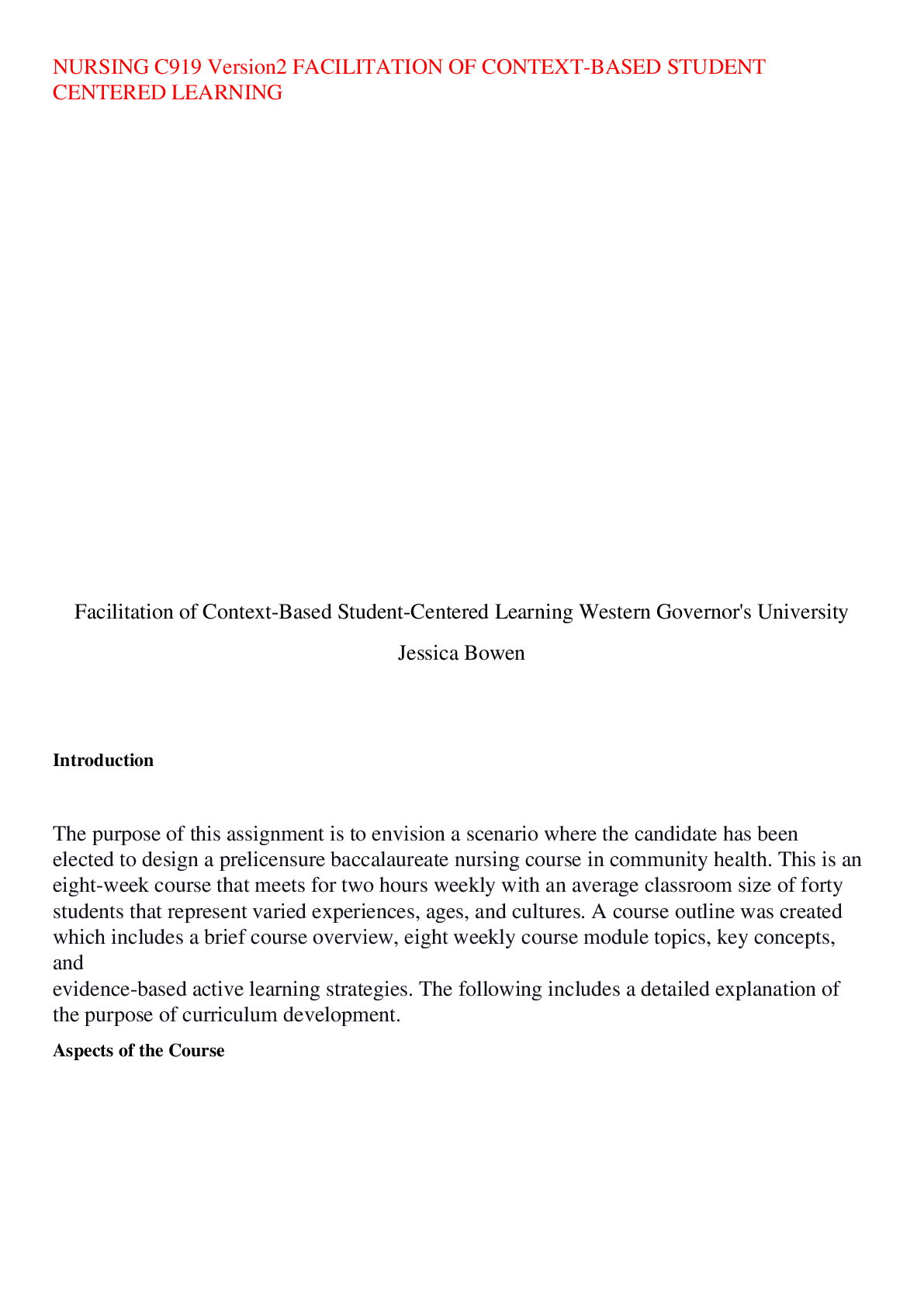
Buy this document to get the full access instantly
Instant Download Access after purchase
Buy NowInstant download
We Accept:

Reviews( 0 )
$15.00
Can't find what you want? Try our AI powered Search
Document information
Connected school, study & course
About the document
Uploaded On
Mar 10, 2023
Number of pages
17
Written in
Additional information
This document has been written for:
Uploaded
Mar 10, 2023
Downloads
0
Views
96


